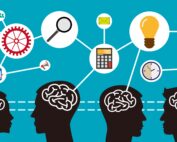What is action learning, why does it work and how can it be used effectively as a professional development tool?
We all know that learning is most valuable when we can put it into practice; just ask anyone who’s done algebra at school how valuable they find it now (assuming they don’t work in a maths related field of course). all too often the learning we undertake has little value in our lives because it remains theoretical, and this is equally as true in the workplace as anywhere else. To truly make the most of learning, and to create a cycle of proactive development, it’s important that it gets put into practice in a real and useful way. That is the aim of action learning; to take what is learnt and find ways to implement it.
How does it work?
action learning is a structured cycle during which individuals are supported by peers and a trained facilitator, to help ensure learning is fully internalised. It typically includes the following four stages:
Learn – This stage describes the point at which an individual learns a new skill or piece of knowledge. It may be part of the action learning session or may occur outside of this and then be brought back to the session to be discussed.
Put it into practice – This is often the stage that gets overlooked post training; individuals are given the time to learn a new skill, but rarely given the opportunity to put it into practice. In action learning, dedicated time is spent deciding on specific ways in which learning can be put into practice, and the potential challenges that may be faced. Once these are clarified, individuals are tasked with carrying out the action.
Review and reflect – This stage of the process will likely happen both within
and outside of the action learning session, but within the session, individuals will present to their peers what they tried, how it went and explore how they can improve. Their peers will ask questions, offer suggestions for improvement and actively support the reflective process, which an individual can then use to decide on a new course of action.
Repeat – at the end of the third stage, individuals will have once again learnt something new that they can then implement moving forward. This allows them to repeat the cycle once more (or as many times as necessary). They may be looking to progress with their original learning issue, or they may have identified a new area of development that they wish to explore. Within the action learning context, the individual will then be supported on an on-going basis to continue this cycle and truly internalise and adopt the learning they need to develop effectively.
Why it works
The reason action learning is so effective is that it combines the three essential elements of successful learning: knowledge acquirement, social interaction, and practice. Too often in learning, these essential elements are either not all present or are disjointed. However, in action learning they are fully implemented in a complimentary way, to create much more robust learning environments where an individual feels not only supported, but encouraged to test out their new skills. When an individual actually has the opportunity to test out their learning, it not only helps embed it, but it also gives them the chance to see if there’s anything else they need to improve, to fully achieve their larger goals. In action learning, once this step is complete individuals then have the chance to explore the situation further, and not just by themselves. With the support of others it showcases a range of new perspectives and viewpoints that they may not have considered before. In action learning sets (the term given to a group of people completing an action learning activity), people are actively encouraged to ask questions, offer their opinions and delve deeper into what an individual is presenting. This then makes the learning much more impactful as it is not just being discussed from one point of view. It may lead to that ‘ah-ha’ moment that can contribute to real and lasting change in an individual’s behaviour, making learning much more worthwhile.
How to deliver successful action learning sets
In an action learning environment the four stages above are incorporated to help solidify and enhance the learning process. It is a technique commonly used in leadership development programmes, but can be used in any setting for any form of learning. Typically it will involve small groups of people coming together to be part of an action learning set. This may occur as a result of attending the same training programme, or it may be people electing to create their own set for a specific purpose.
Identify a facilitator
Due to the need for a relatively high degree of structure in the activities, and the importance of utilising coaching techniques within an action learning set, it is important that there is a suitable facilitator available to help run the sessions. This may be someone internal who is qualified to run action learning sessions; alternatively some groups prefer an external facilitator who can offer an impartial approach.
Either way, it is important to have someone who can help maintain the agreed structure of the group, ensure codes of conduct are adhered to, and encourage an open, constructive discourse.
Make it consistent
Once the group is established and a facilitator has been identified, the important thing is to make sure the sessions occur consistently. During a development programme, for example, the action learning sets will occur at specific intervals throughout. If the action learning sessions are being used as an additional resource for general workplace development, it is still important that a consistent approach is adopted. This may mean monthly action learning sets, or it could be less frequent, depending on the needs of the group, and these may be face to face or telephone sessions. The important thing is that the members of the group agree to the structure and frequency, and that it is re-evaluated as time progresses.
Action learning is a powerful and proactive approach to help make learning activities more effective. It is a simple technique that can be used in any organisation, for any form of development. But it does take commitment from those involved; a commitment to sharing experiences and offering support to one another to empower long term change and growth. But once the commitment has been made, action learning has the potential to lead to real change, and that is something well worth investing in.
Read Next
Soft Skills: Why Being a Control Freak is Hurting Your Project Management Success
Are you a project manager who feels the need to be in control of every aspect of your project? While being detail-oriented and organised can be beneficial, it's important to recognise when your inner [...]
Becoming a Presenting Powerhouse: Mastering The Trifecta of Effective Presentations
Many people assume that some people are just born presenters. But we’re here to let you into a little secret - ANYONE can be a great presenter. And the best part? It isn’t even hard [...]
L&D and HR: A Force to Be Reckoned With
It’s an unfortunate truth, but in many organisations L&D and HR often don’t work well together. Despite the fact that the two functions are traditionally working towards the same goal, there remains a great [...]
Marketing and Communications in L&D
It doesn’t matter how good (or bad) your L&D offering is, if nobody knows it’s there, then it might as well not exist. As learning and development has evolved in its capacity and influence [...]
The death of the linear career path and what it means for professional development
Unlike career routes available in the past, very few people these days will follow a linear career path – it’s no longer about moving up, but moving around. But if people want to be [...]
Skills assurance in a dynamic workplace
With employees taking advantage of more fluid careers, organisations need to have plans in place to address the constant flux occurring within the workplace. One approach is ‘skills assurance’, but what is skills assurance, [...]






